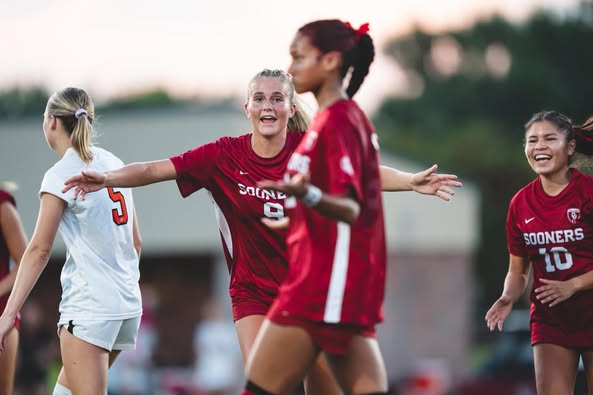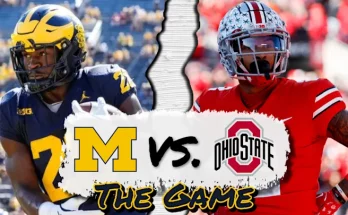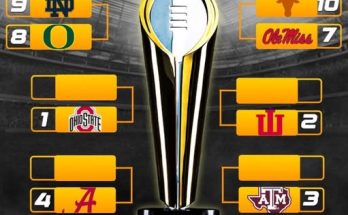Oklahoma Sooners demonstrated their dominance in a heated rivalry matchup, taking down #22 Oklahoma State Cowboys in front of a roaring home crowd with a commanding 4-1 victory. The atmosphere at Gaylord Family Oklahoma Memorial Stadium was electric, as Sooner Nation turned out in force to support their team, creating a backdrop of energy and intensity befitting one of college football’s most storied rivalries. The Sooners’ performance not only showcased their talent on the field but also reflected the unwavering passion and unity of their fanbase, proving that the combination of skill and support can be overwhelming for any opponent.
From the opening kickoff, Oklahoma set the tone with aggressive, disciplined play. The offensive line established control early, providing quarterback Spencer Rattler with the time and space to make accurate throws while also opening lanes for the running game. Rattler, who has been a focal point of the Sooners’ resurgence this season, exhibited poise and precision, connecting on key passes that kept the Cowboys’ defense off balance. His chemistry with his receiving corps, particularly with standout wideouts Marvin Mims and Theo Wease, was on full display as the duo made several contested catches that converted critical third downs. Mims, known for his ability to stretch the field and create explosive plays, had a particularly memorable touchdown reception in the second quarter that sent the crowd into a frenzy, showcasing his elite athleticism and situational awareness.
The running game also played a pivotal role in the Sooners’ victory, with Kennedy Brooks carrying a heavy workload and consistently gaining yardage between the tackles. Brooks’ combination of vision, balance, and power allowed him to break through the Cowboys’ defensive front repeatedly, keeping the clock running and giving Rattler and the passing attack opportunities to capitalize. The ground attack not only helped control possession but also wore down Oklahoma State’s defense, which struggled to adjust to the Sooners’ multifaceted offensive approach.
Defensively, Oklahoma was just as impressive. Linebacker Brian Asamoah led a relentless unit that applied constant pressure on OSU quarterback Spencer Sanders, forcing hurried throws and disrupting the Cowboys’ rhythm. Defensive coordinator Alex Grinch’s game plan was executed to near perfection, with the Sooners’ secondary effectively blanketing receivers and limiting explosive plays. Cornerback Tre Norwood and safety Delarrin Turner-Yell made key stops and highlighted the defense’s ability to anticipate and react to OSU’s offensive schemes. The lone goal the Cowboys managed came late in the game and was a testament more to their persistence than a breakdown in Oklahoma’s defensive execution. Overall, the Sooners’ defense exhibited discipline, intensity, and cohesion, proving that this team is capable of dominating on both sides of the ball.
Special teams also contributed significantly to Oklahoma’s overall performance. Punter Brayden Willis consistently pinned the Cowboys deep in their own territory, forcing OSU to start drives with limited options and placing additional pressure on their offense. Meanwhile, kicker Gabe Brkic was reliable in converting extra points and field goal opportunities, helping the Sooners maintain control of the scoreboard. These often-overlooked aspects of the game were critical in sustaining momentum and preventing the Cowboys from gaining any foothold in the contest.
One of the defining characteristics of this victory was the energy and intensity brought by Sooner Nation. The fans’ presence and support were palpable, creating an intimidating environment for the visiting Cowboys. The stadium reverberated with chants, cheers, and coordinated movements, demonstrating the power of collective enthusiasm in elevating a team’s performance. Players frequently acknowledged the crowd, and it was clear that the energy from the stands translated directly into the intensity and focus displayed on the field. Rivalry games are often as much about the atmosphere as they are about skill, and Oklahoma effectively leveraged both to secure a convincing win.
The 4-1 scoreline tells the story of a dominant but controlled effort by the Sooners. Unlike games that descend into frantic exchanges, Oklahoma maintained composure, executing their game plan with discipline and poise. The coaching staff deserves credit for preparing the team not only strategically but also mentally for the significance of a rivalry clash. Head coach Brent Venables, known for his defensive acumen and ability to motivate players, demonstrated why he is considered one of the most effective leaders in college football. Venables’ approach emphasized fundamentals, adaptability, and situational awareness, allowing the Sooners to maintain control of the game from start to finish.
Turnovers played a crucial role in shaping the outcome. Oklahoma’s defense capitalized on mistakes by the Cowboys, forcing a fumble early in the second quarter that led to a pivotal touchdown. The turnover not only gave the Sooners an immediate scoring opportunity but also shifted momentum firmly in their favor. Conversely, Oklahoma displayed discipline in protecting the football, minimizing costly errors and maintaining possession during critical stretches of the game. This combination of opportunistic defense and careful offensive execution is a hallmark of successful programs and was on full display throughout the contest.
Another factor that contributed to the win was depth. Oklahoma showcased the ability to rotate players effectively without a noticeable drop in performance, keeping athletes fresh and maintaining a high level of play across all quarters. The offensive line rotation, in particular, ensured that Brooks and Rattler had consistent protection, while defensive substitutions allowed Asamoah, Norwood, and Turner-Yell to remain impactful throughout the game. Depth is often a differentiator in rivalry matchups, where intensity and emotional stakes can exhaust even the most talented squads, and the Sooners demonstrated a distinct advantage in this regard.
Beyond individual performances, the victory highlighted the cohesion and unity of the Oklahoma team. Players communicated effectively on the field, executed assignments with precision, and supported each other during high-pressure moments. This sense of camaraderie was evident in celebratory moments after touchdowns, turnovers, and big defensive stops, reinforcing that this is a program built on collaboration and shared goals. Such unity is critical in rivalry games, where external pressures can easily disrupt focus, and the Sooners’ collective mentality was a major factor in their ability to dominate OSU from start to finish.
The impact of this victory extends beyond a single game. Beating a ranked rival like Oklahoma State not only improves Oklahoma’s position in the Big 12 standings but also enhances the program’s reputation nationally. Wins in high-profile rivalry games resonate with recruits, alumni, and media alike, reinforcing the perception of a program on the rise. The performance against #22 OSU sends a message that the Sooners are capable of executing under pressure, handling adversity, and asserting dominance in key matchups—all qualities that bode well for the remainder of the season.
For Oklahoma State, the loss is a reminder of the challenges inherent in competing against a team as well-prepared and passionate as the Sooners. While the Cowboys displayed moments of skill and resilience, they struggled to maintain consistency against a team that executed at a high level across all phases of the game. The 4-1 result reflects both the strength of Oklahoma and the difficulty of performing in a hostile environment where the crowd and atmosphere amplify every mistake and moment of hesitation.
The rivalry aspect of this game cannot be overstated. Oklahoma vs. Oklahoma State has a storied history, and victories carry significance that goes beyond standings or statistics. For the players, alumni, and fans, this win represents a point of pride and a reaffirmation of the program’s competitive tradition. It also reinforces the emotional and cultural connection that Sooner Nation has with its team, highlighting how sports can unite communities and foster a sense of identity and belonging. On this day, the synergy between the team and its supporters was on full display, with the energy from the stands fueling performance on the field and the players delivering a response worthy of the enthusiasm surrounding them.
Looking ahead, Oklahoma will aim to build on this momentum. The combination of effective offense, disciplined defense, reliable special teams, and an engaged fanbase creates a foundation for continued success. Key players like Rattler, Brooks, and Asamoah will be central to sustaining high-level performances, while the coaching staff will continue to refine strategies and exploit matchups to maintain the program’s competitive edge. The energy and confidence generated from such a definitive win over a ranked rival can be transformative, instilling belief in the squad and reinforcing the notion that they are capable of competing at the highest level throughout the season.



